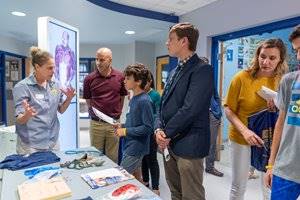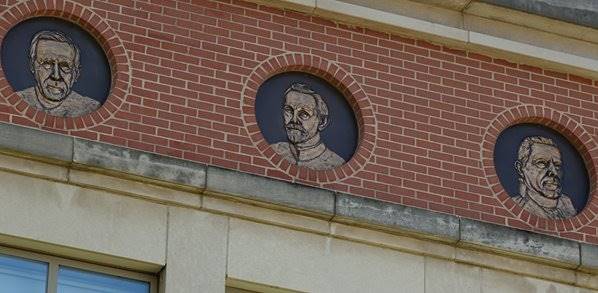 Four hundred years ago, Christopher Clavius was spending his evenings staring up and studying the night sky. The German Jesuit was among the foremost scientists of his time, being asked to interpret discoveries made by Galileo. His work ultimately led to the creation of the Gregorian calendar, by which our world operates today.
Four hundred years ago, Christopher Clavius was spending his evenings staring up and studying the night sky. The German Jesuit was among the foremost scientists of his time, being asked to interpret discoveries made by Galileo. His work ultimately led to the creation of the Gregorian calendar, by which our world operates today.
Today, another scientist named Christopher studies the same sky. Chris Bambic ’14 is pursuing his Ph.D. in Astrophysical Sciences at Princeton University.
“I work in the field of plasma astrophysics, which studies how chaotic interactions among collections of many charged particles drive the most energetic processes in the universe,” he says. “So far, I have had the opportunity to work on questions about how supermassive black holes influence the growth and evolution of galaxies through launching ultra high energy ‘jets’ of charged particles which heat the hot, diffuse plasma permeating galaxy clusters.”
Ten years ago, however, Bambic was a student at Saint Ignatius, spending countless hours in class and extracurriculars in the Clavius Science Center, which turned 20 years old this year and is named for the famed Jesuit scientist.
“I spent many late nights in [retired Physics teacher Mr. Bob Ward’s] classroom in the Clavius Science Center, building projects for our Science Olympiad competitions, including two Rube-Goldberg machines, a pipe instrument, and two robotic arms,” Bambic says.
He credits a long list of teachers with forming him in science, Theology, writing and math. Bambic says, along with “Coach” Ward, veteran Science teacher Tom Bogen was hugely instrumental in helping him pursue his passion.
“Even as a freshman, he gave me the opportunity to join the Science Olympiad ‘A’ team, and I got to be one part of our two-man team for the Astronomy event along with Michael Garn ’11. I spent the next four years lugging around two giant binders of every bit of astronomy knowledge I could get my dad to print out at his office, reading about astronomy constantly,” he says.
 Jacob Pilawa ’16 entered Saint Ignatius on the Fr. Kirby Science track but didn’t hone in on astronomy until his senior year, when he was taking BC Calculus and AP Physics. It was then he began taking pictures of the night sky and joined Science Olympiad.
Jacob Pilawa ’16 entered Saint Ignatius on the Fr. Kirby Science track but didn’t hone in on astronomy until his senior year, when he was taking BC Calculus and AP Physics. It was then he began taking pictures of the night sky and joined Science Olympiad.
“It was the perfect combination of my artistic passion for astrophotography and my academic passion for physics and math, and that blossomed into the career path I am on today,” he says.
Currently, Pilawa is a Ph.D. candidate in astrophysics at Cal Berkeley, where, coincidentally, he is also studying supermassive black holes.
“These objects have been in the news recently, since scientists have, for the first time, imaged the material around the black hole and thus we could see the shadow of a black hole. These objects have enormous consequences for the formation and evolution of galaxies like the Milky Way, but we don't know a lot of the specifics of these interactions. My research focuses on weighing these massive objects and understanding how things so gargantuan form in the Universe,” he says.
After he completes his Ph.D., Pilawa wants to become a professor.
“I hope to combine my passion for astrophysics with that desire to impact other students in the same ways that teachers at Ignatius did for me, and pursuing a professorship seems to be the best way to achieve that.”
Back on Earth, Thomas Graf ’09 is one of the chief residents in pediatrics at Rainbow Babies and Children’s Hospital in Cleveland. After studying biochemistry at Denison University, he attended Columbia University for medical school.
“When I started college, I would have told you that I was definitely not going to medical school,” Graf says. “I ended up doing some shadowing of physicians that I knew, and I found that I really liked what they did. In particular I shadowed my own pediatrician, and I saw that he knew all of his patients as well as he knew me. That was transformational experience because I saw that medicine combined the science of the body with humanism and personal relationships with people.”
Even though his decision to become a doctor didn’t emerge until his junior year of college, some of the seeds for working with children were planted during Graf’s days at Saint Ignatius.
“I think that he most influential extracurricular activity I ever did was after-school tutoring at the Arrupe house,” he says. “Kids in elementary school from Paul Laurence Dunbar School would walk over after the school day ended. You would help them with homework and then play some games together. I really enjoyed being in the role of a teacher and helping children to learn. In medicine you are also a kind of teacher because you are helping people understand their own health and body.”
 Today’s Saint Ignatius students can get up close, firsthand experiences with medicine through the Health Sciences Program and the Pre-Med Society, which provide academic and extracurricular experiences for students of all four years.
Today’s Saint Ignatius students can get up close, firsthand experiences with medicine through the Health Sciences Program and the Pre-Med Society, which provide academic and extracurricular experiences for students of all four years.
Science teacher Tara Henderson coordinates the program, which has a service-learning component and also connects students to internships at local hospitals or medical providers. Experience like that, Graf says, is really important.
“My advice to students who are interested in medicine is to get exposure to it and see what it would be like to be a physician. There are so many different fields within medicine and finding what you are passionate about is very important. In this career you have to love what you do.”
The sciences at Saint Ignatius involve even more than astrophysics and medicine. In addition to robust courses in biology, chemistry, physics, environmental science, and anatomy, extracurricular programming includes Robotics, the STEM Society, and Hydroponics.
This breadth and depth allow students to understand, appreciate and enjoy all that there is to explore in the sciences at Saint Ignatius.
When these students become professors, researchers, entrepreneurs, doctors or engineers, not even the sky is the limit for them.
